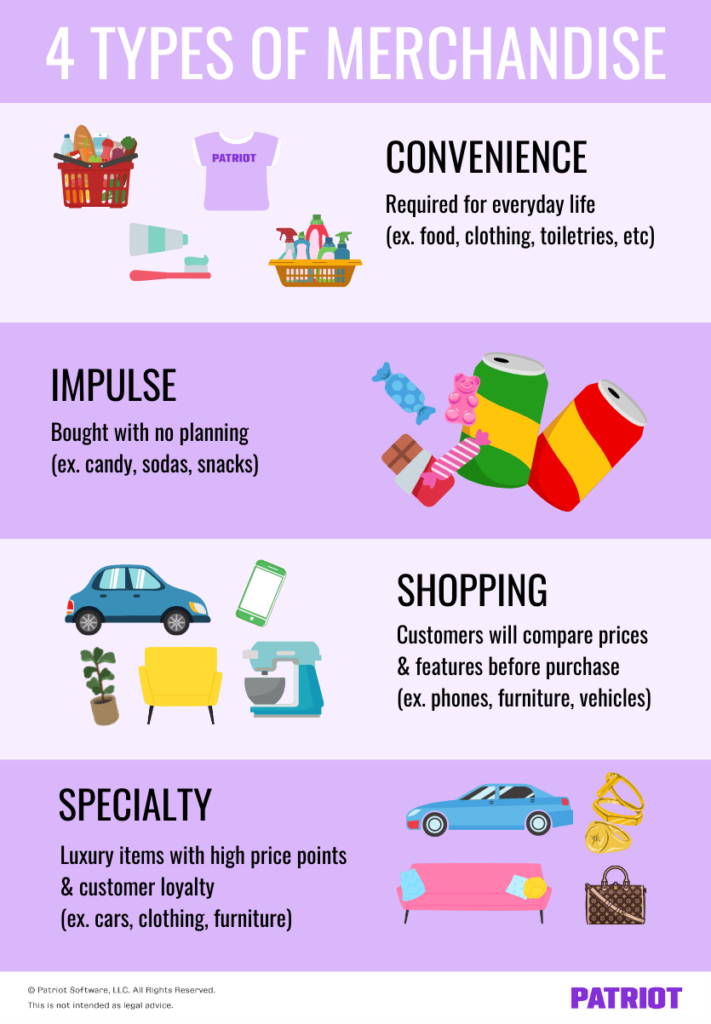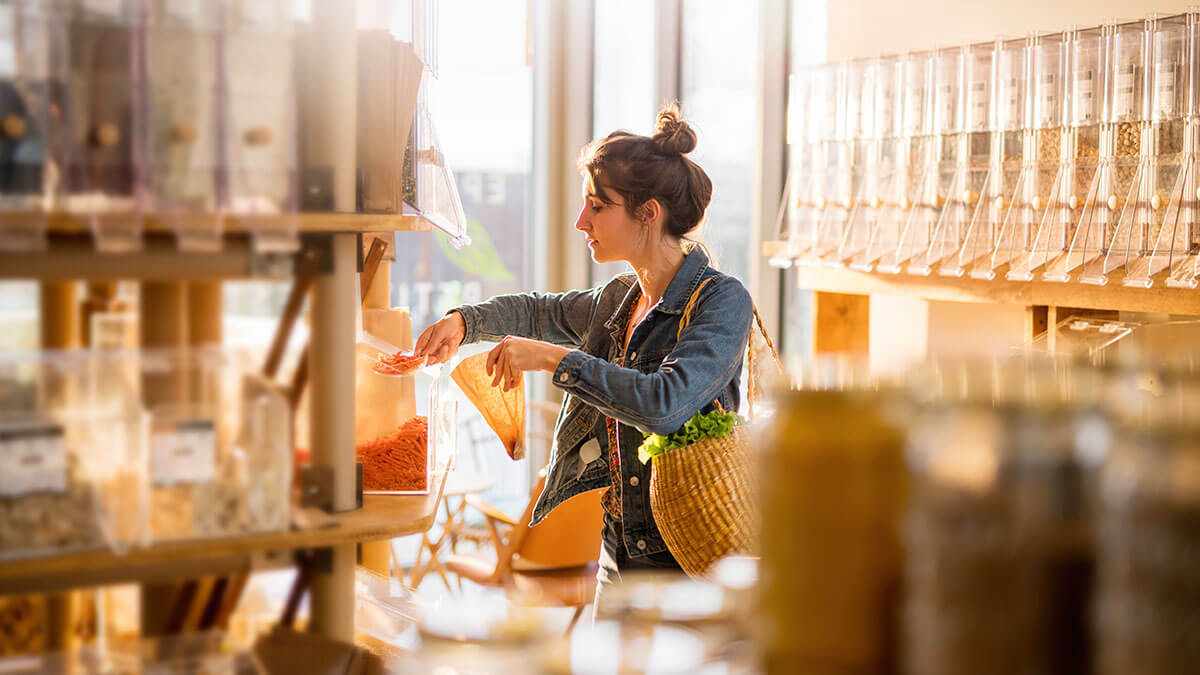Maybe you’re planning on opening up a new store or you just need to spruce things up for the upcoming season. Whatever questions you have about merchandising, we’ve got you covered. Read on to learn exactly what is merchandising and how to harness its power both in-store and online for 2022.
What is merchandising?
Merchandising is the promotion of goods that are for sale. This isn’t just about a clear price tag and an organized display case (although both of these matter!). Merchandising includes a vast array of things—essentially everything you do to make the sale possible:
- Market research
- General marketing strategies
- Display design and presentation (both in-store and online)
- Social media campaigns
- Competitive pricing
Your budget’s ability to turn marketing ideas into fully realized projects shouldn’t hold you back. There are plenty of things you can do that won’t bust the bank and will help your customers decide that your products are just what they need.
What is the difference between retail and merchandising?
Retail is the selling of goods to the public. Merchandising is how you convince the public that they can’t live without what you have to offer. Merchandising makes retail happen.
Merchandising wholesale vs. retail
Merchandising covers both wholesale and retail sales. But, that doesn’t mean that the two are the same thing.
Wholesalers buy items in bulk from producers and distributors and sell those items to retailers.
Retailers buy items in smaller quantities from wholesalers and then sell those items to the customer. Generally, wholesalers offer only a few products. Retailers, on the other hand, may offer a wide variety of things for sale.
Books are a good example of this arrangement. A wholesaler will purchase new titles in hardback and paperback and sell those titles to bookstores. But, bookstores don’t just buy and sell books. They may also offer stationery, tote bags, board games, and magazines. A retailer may work with a number of different wholesalers to offer different types of merchandise to their customers.
Types of merchandise
Don’t confuse merchandising with the merchandise. Whereas merchandising is the promotion of goods, merchandise describes the things for sale.
There are four types of merchandise to keep in mind. Your merchandising approach varies depending on the type of merchandise you sell:
- Convenience: Everyday items that customers can’t live without (e.g., food and hygiene products)
- Impulse: Items that are bought on impulse (e.g., candy, sweet drinks, and novelty items)
- Shopping: Customers do research and compare prices before making a purchase (e.g., electronics, appliances, and furniture)
- Specialized: These items are usually seldom bought and at a higher price point (e.g., international vacations, holiday homes, and luxury items)
Merchandising for convenience items is drastically different than electronic and household items. Convenience items should be easy to get a hold of and displayed in high-traffic areas of your store. But, customers may need time to think about and compare household and electronic items. Consider giving them the space to mull things over and use displays that make comparison easier.

Merchandising options for your business
There are plenty of ways to make your business impossible for customers to ignore. Whether your store is brick- and-mortar, entirely online, or a mixture of the two, there are a few things you should consider.
Brick and mortar
Admit it, sales are up online. Online sales totaled $870 million in 2021, increasing 14.2% over 2020 and by a whopping 50.5% over 2019. But, brick-and-mortar stores are often still the stars of customer experience. The trends offer proof that brick-and-mortars are here to stay—for the last five years, store openings outpaced closures.
Your store is a full shopping experience for your customers. Physical shops also allow for strategic growth in key geographic areas, which can help solidify and expand brand loyalty.
A quick tip: Sales happen when you think of a customer’s experience and how you can make it better than last time.
How to make your store shopper-friendly
Check out these merchandising tips to keep your store fresh and up-to-date:
- Update your windows display monthly. If you stay on schedule, customers will expect to see the next best thing you have to offer
- Rotate entrance displays as often as possible
- Do general updates of your store’s offerings at least every six months
- Don’t ignore the senses! Music, pleasing smells (cookies, perhaps?), and memorable tastes (cookies??) can always help change your customer’s day
Don’t forget about the seasons and cultural events that surround your store. If you can, add on to the big holidays like Easter and Halloween with more local flair, like Madison, Minnesota’s Norse Fest.
Think of your customers and their lives—are there cultural holidays you don’t know about yet? High school graduations or events that you can plug into? Local events can be great merchandising opportunities.
Online sales and social merchandising
If you haven’t tried to get into the e-commerce game with social merchandising, it isn’t too late to start. The world of online retail is growing at a break-neck pace. In 2021, e-commerce sales increased 14.2% since 2020, totaling $870 billion in the U.S. E-commerce represents 13.2% of all retail sales in the country.
You don’t have to be solely online to get a piece of this pie. E-commerce can help supplement your brick-and-mortar and open yourself up to new markets and customers with pinpoint accuracy.
E-commerce
E-commerce is essentially the same thing as your brick-and-mortar storefront, only that your concerns are virtual instead of physical. Instead of a window display, you have your site’s homepage. Instead of a store’s physical organization, you have your site’s online navigation to worry about.
Keep the following merchandising tips in mind when working on your online storefront:
- Remember that graphic design is king. Your audience is already an expert in webpage design and user experience (UX)—don’t let them down
- Always use images that display the best of your product at a glance
- Make sure you use alternative text (alt-text) so users with visual impairments can use screen readers to understand your displayed images
- Create effective product organization with easy searchability. Think of drop-down menus and search filters as you would the aisles of a store–they help the customer find the product they need; keep them clean and easy to navigate
You can also offer online customers a more individualized experience by giving them:
- Updates on the status of their cart. If something sits in their cart too long you may want to nudge them toward completing the purchase
- Ribbon overlays and banners to promote offers based on items the customer has previously looked at or purchased
- Live chat support if the customer has any questions
- User-generated content (UGC) and reviews in case your customers happen to be social shoppers (they probably are!)
Social merchandising
Social merchandising is quickly becoming an indispensable tool for online stores. Like merchandising, social merchandising covers market research, marketing strategies, design and presentation, targeted marketing, and competitive pricing—all of which take place online.
What makes social merchandising stand out from more conventional marketing is how finely tuned social merchandising campaigns can be thanks to the use of social media, user data, and user-generated content.
Social media
You’ve probably seen social merchandising use social media to try and get your attention. In 2020 more than 90% of retail businesses were active on two or more social media platforms. And for good reason, the average adult spends almost two and half hours on social media each day.
Plenty of businesses already use sites like Facebook and Instagram to fight for shopper attention. There are a few things that you’ll need to do before you jump into the fray.
- Know your audience and what social media platforms they use. For example, TikTok’s largest demographic is 10 to 19-year-olds (at 1 billion monthly users), while Facebook’s users are, on average, 25 to 34-year-olds (at 2.91 billion monthly users)
- Know the tools, tricks, and expectations of different social media platforms. What works on TikTok probably won’t work on Facebook
- Post the most visually interesting content you can
- Network with other retailers and influencers to increase your reach
- Create templates or checklists for each thing you do
- Keep track of what works and what doesn’t. Just because you’re on social media doesn’t mean that your work is done. It means that the trial and error (fine-tuning your approach) has just begun!
Remember that you only have eight seconds to get your customers’ attention with social media merchandising campaigns. You can increase your chances of keeping a customer’s attention when you track what they’ve bought in the past and make educated guesses on what they’ll want in the future.
User data
User data is used in brick-and-mortar merchandising, but it’s a different thing altogether in the world of social media and e-commerce.
With the help of online tools, user data can help you:
- Target consumer behaviors: Each user is unique–they’ll have certain habits and items that they gravitate toward. Knowing these things can help you with targeted emails, coupons, and even birthday sales
- Craft a personalized shopping experience: Knowing a customer’s preferred price point and average browsing time can help you hone in your offerings and your timing
User data is a tough issue in 2022—69% of customers are concerned with how their data is collected and used online. Politicians are listening and creating laws to limit big data’s reach.
In 2018, the European Union passed the General Data Protection Regulation (GDPR) which allows consumers to opt-out of data collection, know what’s collected, use that information for themselves, and choose to have that information completely deleted.
California, Virginia, and Colorado have passed similar laws. In general, they allow consumers to opt-out of data collection. As of yet, there isn’t a federal law that regulates the collection and use of user data in the United States.
To be clear, this doesn’t mean that using user data is illegal. But, it does mean that everyone is watching.
Quick tip: Be smart and be honest with your customers. Let them know what information you collect, how you use it, and give them the chance to say no if they want. You might lose some data, but you’ll gain customer trust and loyalty.
User-generated content
User-generated content (UGC) helps connect shoppers with user reviews and friends in their wider social network that have shopped with you in the past. UGC helps customers feel part of the in-crowd and helps online shopping evolve from a solitary experience to one that is more social and interactive.
The social proof is in the pudding. A recent study shows that without interacting with UGC, 3.4% of online shoppers converted. But when shoppers interacted with UGC, things changed rapidly. When a shopper sees (but doesn’t interact) with UGC conversion rates bump up to 4.3%. But when a shopper actually interacts with UGC conversions skyrocket to 108.4%. So, be smart and trust your customers to help your brand.
Offer UGC in the form of:
- Reviews
- Q & As
- User images
UGC isn’t just for e-commerce. Think about merchandising with UGC in your brick-and-mortar stores to help connect local shoppers with a larger community.
Final thoughts
Whatever path you choose to help convert shoppers into loyal customers, be sure to think of their experience first. Making customers feel comfortable both in-store and online is the key to merchandising in 2022.
This is not intended as legal advice; for more information, please click here.
